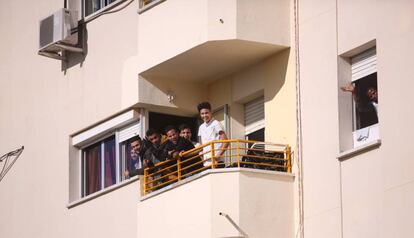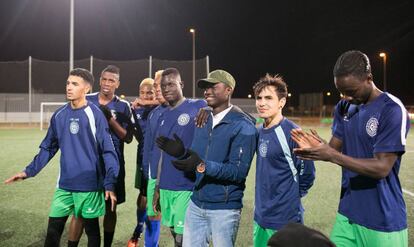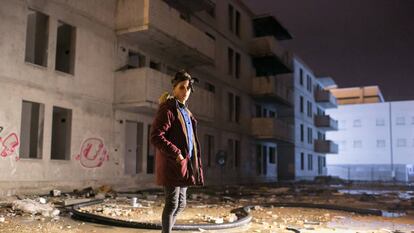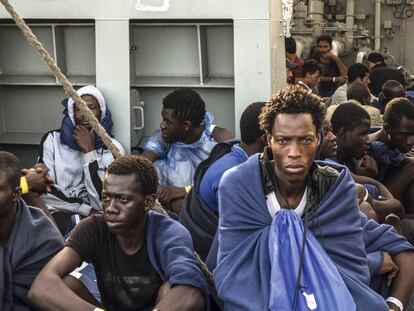Turning 18: The second ordeal for migrant children who make it to Spain
Thousands of unaccompanied minors reach Europe every year, but those who end up on Spanish shores face bureaucratic hurdles and overcrowded centers once the system that took them in leaves them to fend for themselves
The loud sounds are coming from an apartment located on Maestro Teófilo Square, in the Andalusian city of Jerez de la Frontera (Cádiz province). Behind the door, around 20 young men are trying to contain their laughter as they speak to one another in different languages: Arabic, Bambara, French. Some of them are playing Parcheesi, others are searching for a Wi-Fi signal as they sit on the couch in the brightly lit living room.
Practically all of them arrived in Spain as children, and were wards of the state until they became adults. “I left the youth center on the day that I turned 18, on March 8. The trouble is that I left with no information and no diploma,” says Malick Doumbouya in a quiet voice. He didn’t even have any ID, save for a useless birth certificate from his home country.
Malick, a slender young man with dark eyes and a wide smile on a beardless face, had arrived by sea on a dinghy nine months earlier. Everything had been planned ahead of time: a friend gave him a ride on his motorcycle from his native village in Guinea Conakry to the border with Mali, where another friend showed him the way to Morocco. He was 15 at the time.
Their journey requires the kind of boldness and ingenuity that many adults only wish they had
But there was one thing he had not planned for: Spanish bureaucracy. When he turned 18 he ended up in this apartment, which is run by the non-profit group Voluntarios por Otro Mundo – the same organization that helped him secure a residency permit for former state wards. This document does not extend work authorization, however.
“I don’t know why they do that,” he wonders, looking out the window to see if the players for the Alma de África team have arrived on the field. Malick is training with this all-migrant soccer team in the hopes of being signed.
Just like Malick, hundreds of youths enter Spain illegally every year. To the law, they are underage. But their journey requires the kind of boldness and ingenuity that many adults can only wish they had. To Spaniards, turning 18 means being able to drive and vote; to an immigrant, it is the thin line separating two worlds.
“It conditions everything else,” underscores Catalina Perazzo, a researcher for Save the Children. It is the difference between having the right to state protection and becoming a candidate for deportation. “Their age should be considered above their foreign nationality,” adds Perazzo, noting that authorities often work the other way around, questioning the age that shows on the migrant’s passport.

Although records show a drop in unaccompanied teen arrivals over the last decade, there has been a new spike (in 2016 there were 588, following a 42% rise from the previous year and a 85% surge between 2014 and 2015). This is still a contemptible figure compared with the 33,000 minors who arrived in Italy, Greece, Bulgaria and Spain combined in 2016, according to UNICEF.
That year, nearly 4,000 minors were wards of the Spanish state. Around a quarter of them were living in the Spanish exclave city of Melilla, on the northern coast of Africa. Another 25% were located on the Spanish mainland, in the southern region of Andalusia. Perazzo, of Save The Children, notes that the Childhood Observatory, an agency representing the central government, regional authorities and non-profits, has proposed a resettlement plan to relieve the pressure on these two areas. Two youths died in Melilla, one in December and another one in January, and the Ombudsman is investigating the circumstances surrounding their deaths.
In 2017, 28,300 people reached Spain illegally, the highest figure in a decade according to the United Nations. Around 9,000 of these migrants reached the Andalusian coast by boat. Alicia Núñez, head of the youth center network in Andalusia, admits that it was a complicated year. There were 4,163 unaccompanied minors, 70% of whom hailed from Morocco, with a spike in arrivals from Algeria, Ivory Coast and Guinea.
I want to play with them. Everybody treats me well, they consider me their brother
Malick, about the Alma de Africa soccer team
Last summer, unions reported that the region’s centers were at saturation point, and the Andalusian government made a controversial decision to house around 60 minors at a campground. “There were many moments of overcrowding, but you can’t keep empty centers around just in case, either,” notes Núñez.
It is drizzling outside. Malick goes out for a walk with his friend Mamourou and stops in front of the place where they met: the Manuel de Falla Youth Center. Located on the corner of a residential block, the facilities have room for 18 teenagers, yet in 2017 there were as many as 60 at one point. “When there’s more people, someone has to sleep on the floor,” says Malick.
Inside the hallway, the walls are adorned with black-and-white photographs of children. A counselor explains that two decades ago she was working mostly with Spanish kids. “Since then, we’ve had to learn new languages, customs, types of food, religions and cultures,” she notes.

“Because of saturation at these centers, inclusion programs have been dropped and there is only primary care service now,” says José Carlos Cabrera, a researcher at Granada University and former worker at El Cobre de Algeciras Youth Center.
According to him, overcrowding is the last symptom of a system that is deficient at the root. “We are assisting young people [...] at a youth protection center, not at specific centers for foreigners,” he says, noting that the existing structure was designed in the 1920s with the needs of Spanish children in mind.
Each one of the Moroccan youths who arrived in Spain had personal motives to do so. “They are not always pushed by poverty or the need for a job. They want to move away from home. Just like Mexico and the Philippines, Morocco is one of the world’s biggest recipients of remittances,” explains Mercedes Jiménez, an anthropologist who has been living in Morocco for 20 years and lives in Tangiers. “Many Spanish customer care services are based in Morocco; the snails served at tapas bars in Seville come from Larache, Zara clothes are sewn right here. Everything around them is in motion, and mobility is a form of social climbing. And they want to be global subjects too, to see the Eiffel Tower, to stand inside the Real Madrid stadium...”
The requirements to access formal education have become tougher
Catalina Perazzo, Save The Children
Nour did not know what was awaiting him in the Spanish city of Melilla, on the northern African coast. This Moroccan youth who now plays as a midfielder in the Alma de África team recalls how he crossed the border at age nine with his brother, who was 10. He considers himself lucky: at the center where he was sent, he got to study and play soccer. Later Nour came to mainland Spain and now, at age 23, he is continuing his education. The next step is applying for Spanish citizenship. His brother is not in the same situation: he ran away from the center.
More than 800 youths ran away from centers in 2016. Ayoub, a 19-year-old from Morocco, fled around a dozen of these facilities before turning 18. “I like to be alone,” he claims. He is skinny and has spent the last six months living inside a derelict building in Jerez that overlooks a courtyard covered with trash and mud. There is no electricity, no running water and no glass in the windows.
“I came here because people in Morocco always say, ‘Spain! Spain has money!’,” he says. Ayoub crossed the Strait of Gibraltar at age 11. Now he spends his afternoons hanging around the city with other former wards who sleep in shelters or apartments run by non-profits. He partly regrets his decision to emigrate: “I thought I was going to find a future here... but I’m still dreaming.”
The challenge posed by unaccompanied migrant children is nothing new. In the mid-19th century, New York authorities disposed of 200,000 German, Italian and Irish kids who had arrived as stowaways in ocean liners by putting them on trains headed for the Midwest, as the columnist Valeria Luiselli wrote about in this newspaper. The kids could fend for themselves once they got there. Problem solved.
Things have gotten better since then, but there is still a lot of scope for improvement. Isabel Lázaro, a professor of law at Pontificia Comillas University and a specialist in juvenile issues, lists “the very serious problems in general. And then there is Melilla, which is a world unto itself.”

Lázaro holds that “there is no political will to identify these minors, and the processes to determine their age do not guarantee minors’ rights. In the end, the prosecutor decrees [whether the youth is over or under 18] and there is no appealing this.”
Authorities also fail to make efforts to determine whether these youths require asylum or are victims of people smuggling, she adds.
“A mistake in age determination can mean having kids on the streets who are passing themselves off as adults,” says Sara Collantes, of UNICEF.
This was the experience of the teenagers who ended up in CIEs, the holding centers for illegal immigrants prior to their deportation.
In May, it will be 12 years since Modou has been in Spain without legal residency papers. “Twelve years without papers!” he exclaims. A native of Senegal, he says he arrived in Spain at age 15 but never went to a youth center. “If I had, now I would have Spanish citizenship,” he laments.
I thought I was going to find a future here...but I’m still dreaming
Ayoub, 19, from Morocco
He landed in the Canary Islands during the peak of boat arrivals in the Spanish archipelago, and the police put him down as a minor. But when records from Senegal arrived, it turned out that his own father had reported him as being three years older than he really was. “I am 26, but my papers say I am 29,” he says.
Assisting underage migrants is a titanic task that is made harder by the web of laws and institutions involved. The legal complexity is such – with regulation that includes foreigner, asylum and juvenile protection laws and multiple actors at the national and regional levels – that it puts them in a vulnerable situation, say the experts. For instance, the likelihood of being considered under 18 varies greatly from one region to the next. These tests are controversial, and the margin of error is huge, 18 months.
Alicia Núñez, head of the youth centers in Andalusia, notes that more than 70% of wards in the region are over 16 years old. “Of those, 52% are between 17 and 18, which means that we have just a few months to identify them, get their papers, and work on social and labor integration.”
The non-profits are critical of the slow pace at which authorities declare a youth to be a ward of the state, which opens the way to residency application (not work visas, however).
“Although the MENAS (jargon for unaccompanied migrant minors) protocol reduces this to three months, it largely depends on the educator, on the center, on the city or region, and even on the government delegate,” says the expert from Save The Children.
The Ombudsman and activists criticize the fact that unaccompanied youths with a residency permit are not allowed to work once they reach the age of 16. “It does not serve the best interest of the minor, who is being discriminated against compared with accompanied minors,” says the Ombudsman’s annual report.
In other words, if you came here with your parents or an adult sibling, you’re allowed to work, but if you came alone, you’re not. José Miguel Morales, secretary general of the support association Andalucía Acoge, explains that this permit is aimed at the children of immigrants who stay with their parents until age 18.
“There is no specific measure for these other kids,” he says about the unaccompanied ones. “And the bad part is that they could be trained in professional skills.”
For Malick, the toughest part was not the journey across Africa, or the months he spent in a forest before boarding a makeshift boat for Spain. The hardest part was living in the youth center, and the thing he missed the most was being able to study. He still dreams of becoming an economist, although his hopes of getting some kind of diploma at the center were dashed.
“The requirements to access formal education have become tougher,” explains Perazzo. After he turned 18, Malick took a course thanks to the non-profit group CEAin; he later got a job at a restaurant as a kitchen aide, and now he will be able to obtain work authorization. He is also waiting for the consulate to give him his passport. He’s been to Madrid to apply in person, and visited Bernabéu stadium while he was there.
Legal papers are a requirement to play for Alma de África. “I want to play with them. Everybody treats me well, they consider me their brother,” he says. Malick’s fear is that he won’t be accepted because he is not tall enough. “But I am good at defense. I grab the ball and I play very good defense.”
This story is part of a project called The New Arrivals, funded by the European Journalism Centre with support from the Bill & Melinda Gates foundation, in which EL PAÍS is a participating member together with The Guardian, Der Spiegel and Le Monde.


